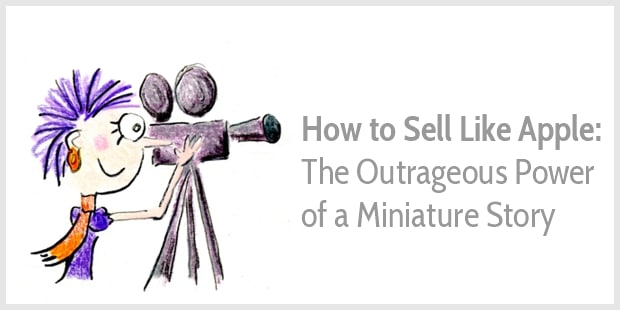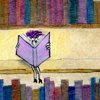 Have you ever been engrossed in a book?
Have you ever been engrossed in a book?
So engrossed that you couldn’t put it down?
You didn’t notice what was happening around you. You didn’t hear your phone ringing. You let your coffee go cold.
That’s because you were living the story; you had become part of it.
It’s not the same when you read sales copy, eh?
You read how fantastic a product is. You stumble over superlatives. Best-in-class. Fastest. Amazing.
Yeah, yeah, you think. You’ve heard it all before. Ad speak. Marketer’s drivel. Pushy sales talk.
Sales copy often turns readers off.
As soon as readers detect a hint of marketese, their defenses go up.
So, what if you could write sales copy like a storyteller?
Could you enthrall your readers and persuade them to buy?
When we read a good sales story, we don’t notice we’re being sold to. We pay attention to the story, and the story seems to make a product more valuable. Our desire to own it increases.
How do you tell such a sales story?
Today, I’d like to share with you a story by Apple.
At first glance, their story explains how they developed the Cinematic mode.
But the story is really about handing you the creative power to transform yourself into a Hollywood director.
And it’s that transformation that makes the story so powerful.
Shall I explain?
A sales story from Apple (example)
The 243-word story below is from the sales page for the iPhone 13 Pro.
To bring Cinematic mode to iPhone, we carefully studied how master filmmakers use rack focus to add drama and emotion to the story.
On Hollywood shoots, pulling focus requires a talented team of experts. Like a cinematographer, who makes the overall call about what’s in focus and when that changes. And a focus puller, who makes sure the transition is smooth, the timing is spot on, and the subjects are perfectly crisp.
Making all this happen automatically on your iPhone was no small feat.
First we had to generate high-quality depth data so Cinematic mode knows the precise distance to the people, places, and pets in a scene. And because this is video, we needed that depth data continuously — at 30 frames per second.
We also trained the Neural Engine to work like the experts. It makes on-the-fly decisions about what should be in focus, and it applies smooth focus transitions when that changes. If you want creative control, you can always hop in the director’s chair and rack focus manually, either when you shoot or in the edit.
It’s so computationally intense, we needed a chip that could handle the workload. Enter A15 Bionic.
The sheer computational power needed to run the machine learning algorithms, render autofocus changes, support manual focus changes, and grade each frame in Dolby Vision — all in real time — is astounding.
It’s like having Hollywood in your pocket.
A powerful image, eh?
The creative powers of Hollywood in your pocket.
How Apple’s sales story sells
A good opening sentence arouses curiosity, so readers want to know more and read on.
Apple’s copywriters tap into our hunger for knowledge by promising us we’ll learn something:
See how we trained your camera to be a cinematographer.
This opening sentence raises questions: Can a camera really be a cinematographer? And how was it trained?
We read on to find answers to those questions.
First, the story shows us how master filmmakers work. We see how the cinematographer makes the call about what’s in focus; and we watch on as the focus puller smooths transitions.
Next, the story transitions to the development of the Cinematic mode. It was no small feat: The Apple engineers generated depth data at a rate of 30 frames per second; and they trained the Neural Engine to make decisions like the Hollywood experts.
So, the story lets us appreciate the hard work of the Apple engineers. But that’s not the purpose of telling the story. What Apple really wants to tell us is that they’re handing the creative powers to us—their readers, their customers.
We can let the iPhone focus automatically or we can hop in the director’s chair and focus manually. Either way, we can transform ourselves into Hollywood directors.
Apple’s story doesn’t sell a product; it sells a more creative life.
The shortest sentence in this story
In their sales copy, Apple often use the shortest sentences to stress key benefits.
But here, they’ve taken a different approach.
The shortest sentence:
Enter A15 Bionic.
That’s the key feature. It may sound technical. But we know it matters: This is where the magic of the Cinematic mode lies. Thanks to this magic, we can turn ourselves into Hollywood producers.
Read the story aloud and you’ll notice that the writing gently flows. And then … Boom! The A15 Bionic enters with a bang.
The shortness of the sentence adds stress and a sense of importance. As Roy Peter Clarke suggests, “Long sentences take readers on a journey. Short sentences tell the gospel truth.”
That 3-word sentence is important. Because, yes, the A15 Bionic is important.
But the hero in this sales story is not the A15 Bionic, it’s not the iPhone, it’s not the team of Apple engineers, it’s the customer—it’s you.
Because the story lets you imagine how the iPhone can transform your life. And that’s what the closing sentence confirms:
It’s like having Hollywood in your pocket.
Remember: People don’t buy a product, they buy a better life.
How to sell your product or service with a story
Telling short sales stories doesn’t require a special talent or storytelling gene.
You only need 3 ingredients:
- Actions to create drama:
The Apple story narrates how they studied the Hollywood experts and how they trained the Neural Engine. Without actions, there’s no story.
- Details to help your audience imagine the story:
We almost feel like we’re looking over the shoulders of the Hollywood cinematographer and focus puller to see them at work. Plus, a detail like the 30 frames per second adds credibility to the story; it feels real.
- A transformation to make the story worth telling:
The story makes you want to transform yourself from mediocre filmmaker to Hollywood-style director; it makes you want an iPhone.
This same approach works in any field.
Whether you’re a yoga instructor or a marketing consultant, a mindset coach or business strategist, sales stories can captivate your audience and make them eager to work with you.
Take your audience by the hand and let them imagine how you help them transform their lives.
How will they be happier, more productive, more relaxed, or more successful?
P.S.
Stories in Miniature is a self-paced course that teaches you step by step how to tell stories in social media posts, emails, blog posts, sales pages, books, and courses:
More on Apple’s copywriting:
How to write seductive sales copy like Apple
How to vary sentence length
How to write for impact: 8 science-backed tips


Jeez, maybe I should rethink my OnePlus purchase. I haven’t opened the box yet, so I could easily swap it out for an iPhone.
This post reminds me to log into your course that I bought before a recent busy spate of work. Love the course, btw.
I’m glad you’re enjoying the Stories in Miniature course. You have lifetime access so you can dive back in when works eases a little.
Great tips Henneke, thanks for breaking them down in digestible bits. Apple copywriting is (still) very good. Wondering if there will be a decline in quality at some point.
I don’t know. Will keep an eye on it! They definitely messed up their latest advert but mostly they seem to know what they’re doing.
Hello Henneke!
Your way of analyzing Apple’s approach is so inspiring. I seriously think you should consider writing a book about Apple’s way of creating copy. I am convinced that the book would be a guaranteed success.
Hello Pär, that’s a lovely compliment. Thank you.
I once asked a copyright expert (a lawyer) about quoting copy from websites in books. He said it would be okay as long as I’d use a variety of sources and quote copy for educational purposes only.
He suggested using copy from just one website (one brand) could potentially lead to copyright issues. So, while such a book would be fun to write, I am a bit nervous about doing it.
I somehow doubt that Apple would really sue if I’d do it but I am not sure I want to take the risk. And asking permission beforehand seems kind of tricky, too.
My thought was that Apple might pay you. That’s the way all the young people do it these days: a post about a product goes viral, and then they get paid for it.
Or at least a new iPhone with all the Dolby features — I seriously went to check out the phone after your post.
I don’t accept any sponsorship. I prefer keeping my independence. Maybe a bit old-fashioned? Oohh, and I don’t own an iPhone either. I’ve got a 6 year old Android phone.
Great read! This sales story example is a gem! Engaging narrative, strategic structure, and compelling call-to-action. Thanks for the insightful breakdown, it’s truly inspiring!
Thank you. I’m glad you enjoyed it, Cat. Happy storytelling!
Thank you for the explanation about the story on iPhone 13.
It’s funny you wrote about this because I read yesterday your article on the same iPhone 13.
https://www.enchantingmarketing.com/varying-sentence-length-examples/
It’s a good idea to sell with storytelling. It makes me want to do the same. Moreover, it’s short.
When I see the leeeeength of the usual sales pages, I don’t read them.
Thank you for your advice at the end of this article. It’s precious. 💗
Ah yes, I know I used part of this story before. I had thought that nobody would remember, but you did!
Sometimes, sales stories stand on their own but quite often they are part of longer sales pages. I think they can engage or re-engage readers. But of course, if you’re not interested in a particular product and what it can do for you, then the sales page with or without stories will not engage.
Hi Henneke, I love this story! They make it seem so easy but it really takes a lot of imagination and creativity.
You make your point with this example how the right copy can transform lives, thank you for sharing about it with us.
I love this example, too. It’s maybe little more complicated than most stories in miniature (they can really be simple!) but it’s so smartly done.